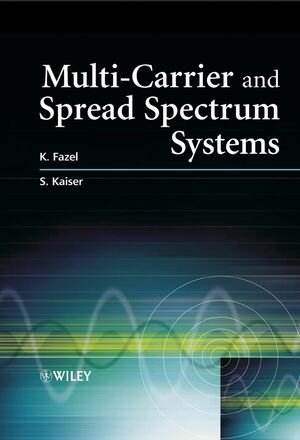
„This highly accessible work describes and analyzes the basic concepts of the combination of multcarrier transmission with spread spectrum (MC-SS).“ (IEEE Solid-State Circuits Society Newsletter, January 2004)
Frequency spectrum is a limited and valuable resource for wirelesscommunications. A good example can be observed among networkoperators in Europe for the prices to pay for UMTS-frequency bands. Therefore, the first goal when designing future wirelesscommunication systems (e. g. 4G - fourth generation) has to be theincrease in spectral efficiency. The development in digitalcommunications in the past years has enabled efficient modulationand coding techniques for robust and spectral efficient data, speech, audio and video transmission. These are the multi-carriermodulation (e. g. OFDM) and the spread spectrum technique (e. g. DS-CDMA), where OFDM was chosen for broadcast applications (DVB, DAB) as well as for broadband wireless indoor standards (ETSIHIPERLAN-II, IEEE-802.11) and the DS-CDMA was selected in mobilecommunications (IS-95, third generation mobile radio systems worldwide, UMTS/IMT 2000).
Since 1993 various combinations of multi-carrier (MC) modulationand the spread spectrum (SS) technique have been introduced and thefield of MC-SS communications has become an independent andimportant research topic with increasing activities. Newapplication fields have been proposed such as high rate cellularmobile, high rate wireless indoor and LMDS. It has been shown thatMC-SS offers the high spectral efficiency, robustness andflexibility that is required for the next generation systems. Meanwhile, different alternative hybrid schemes such as OFDM/OFDMA, MC-TDMA, etc. have been deeply analysed and adopted in differentinternational standards (ETSI-BRAN, IEEE-802 & MMAC).
Multi-Carrier & Spread-Spectrum: Analysis of Hybrid AirInterfaces draws together all of the above mentioned hybrid schemestherefore providing a greatly needed resource for system engineers, telecommunication designers and researchers in order to enable themto develop, build and deploy several schemes based onMC-transmission for the next generation systems (which will be anintegration of broadband multimedia services covering both 4Gmobile and fixed wireless systems).
* Offers a complete treatment of multi-carrier, spread-spectrum(SS) and time division multiplexing (TDM) techniques
* Provides an in-depth insight into hybrid multiple accesstechniques based on multi-carrier (MC) transmission
* Presents numerous hybrid multiple access and air interfacearchitectures including OFDM/CDMA, MC-CDMA, MC-DS-CDMA andMT-CDMA
* Covers new techniques such as space-time coding and softwareradio
Telecommunications engineers, hardware & software systemdesigners and researchers as well as students, lecturers andtechnicians will all find this an invaluable addition to theirbookshelf.
Since 1993 various combinations of multi-carrier (MC) modulationand the spread spectrum (SS) technique have been introduced and thefield of MC-SS communications has become an independent andimportant research topic with increasing activities. Newapplication fields have been proposed such as high rate cellularmobile, high rate wireless indoor and LMDS. It has been shown thatMC-SS offers the high spectral efficiency, robustness andflexibility that is required for the next generation systems. Meanwhile, different alternative hybrid schemes such as OFDM/OFDMA, MC-TDMA, etc. have been deeply analysed and adopted in differentinternational standards (ETSI-BRAN, IEEE-802 & MMAC).
Multi-Carrier & Spread-Spectrum: Analysis of Hybrid AirInterfaces draws together all of the above mentioned hybrid schemestherefore providing a greatly needed resource for system engineers, telecommunication designers and researchers in order to enable themto develop, build and deploy several schemes based onMC-transmission for the next generation systems (which will be anintegration of broadband multimedia services covering both 4Gmobile and fixed wireless systems).
* Offers a complete treatment of multi-carrier, spread-spectrum(SS) and time division multiplexing (TDM) techniques
* Provides an in-depth insight into hybrid multiple accesstechniques based on multi-carrier (MC) transmission
* Presents numerous hybrid multiple access and air interfacearchitectures including OFDM/CDMA, MC-CDMA, MC-DS-CDMA andMT-CDMA
* Covers new techniques such as space-time coding and softwareradio
Telecommunications engineers, hardware & software systemdesigners and researchers as well as students, lecturers andtechnicians will all find this an invaluable addition to theirbookshelf.






